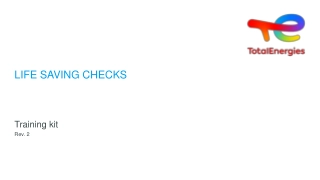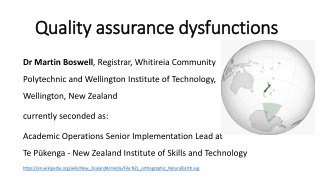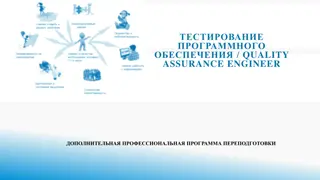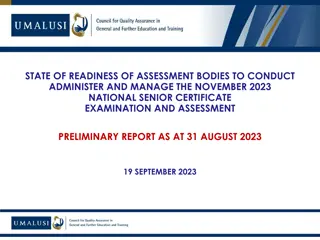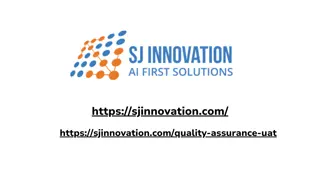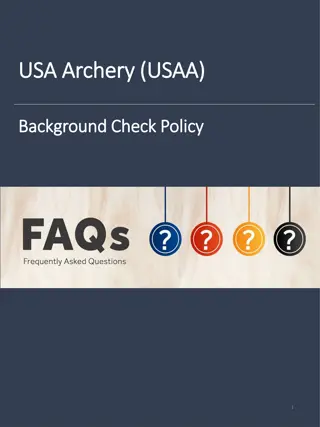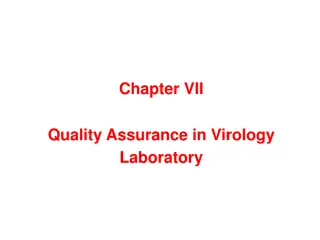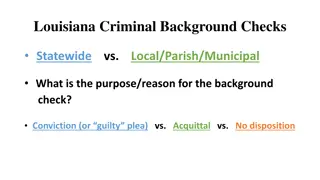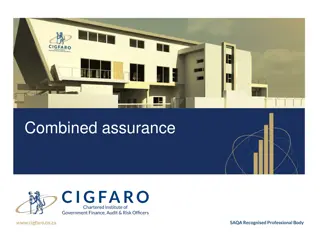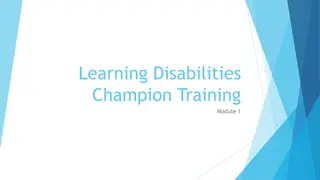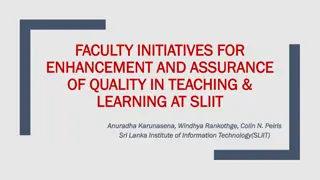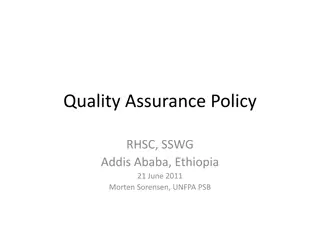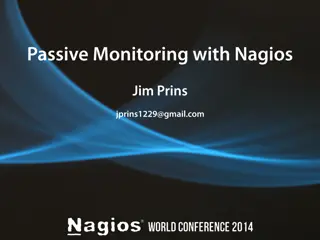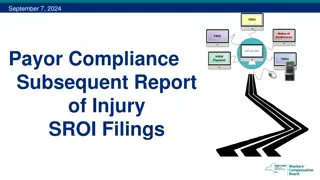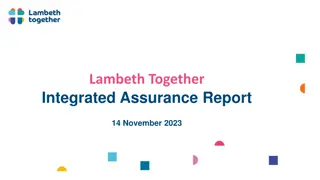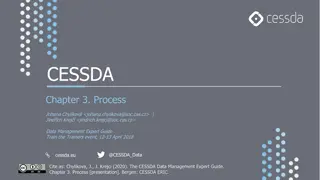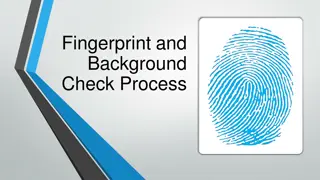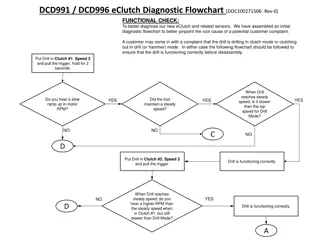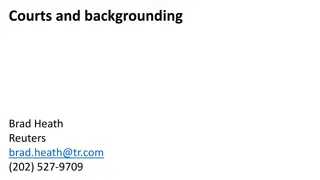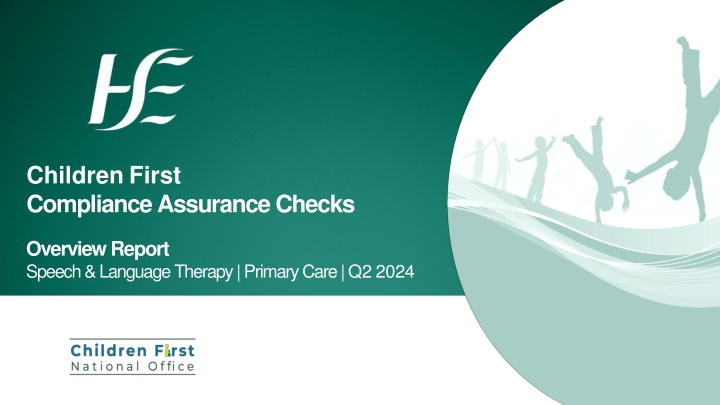
Assessment of Children First Compliance Checks in Speech & Language Therapy Services Q2 2024
"Discover the findings and suggestions for improvement from Children First Compliance Assurance Checks conducted in Speech & Language Therapy services in Q2 2024. Good compliance levels noted with a few non-compliant instances highlighted for corrective actions."
Download Presentation

Please find below an Image/Link to download the presentation.
The content on the website is provided AS IS for your information and personal use only. It may not be sold, licensed, or shared on other websites without obtaining consent from the author. If you encounter any issues during the download, it is possible that the publisher has removed the file from their server.
You are allowed to download the files provided on this website for personal or commercial use, subject to the condition that they are used lawfully. All files are the property of their respective owners.
The content on the website is provided AS IS for your information and personal use only. It may not be sold, licensed, or shared on other websites without obtaining consent from the author.
E N D
Presentation Transcript
Children First Compliance Assurance Checks Overview Report Speech & Language Therapy| Primary Care |Q2 2024
Services selected for Compliance Check Speech and Language Therapy (SLT) services provided as part of HSE Community Healthcare Networks were selected to undergo HSE Children First Compliance Assurance Checks in Q2 2024. All SLT Service Managers and Heads of Service for Primary Care were invited to attended an Information Session which took place on 11th April 2024 and all were provided with a copy of the HSE Children First Compliance Assurance Framework. Nine SLT Services (one from each CHO) were randomly selected to undergo a Check. Compliance Assurance Checks took place between April and July 2024.
Overview of Findings and Suggestions for Improvement
Overview of Findings Areas of Compliance CSS in accordance with legislative requirements 6 3 0 Sufficient Risk Assessment undertaken CSS in accordance with Tusla guidelines CPW Policy Declaration HSE staff (appendix 3) CSS CSS CPW Record Mgt Procedure CPW Reporting Procedures CSS reviewed within 24mths Elearning Completed Self-Audit Checklist Displayed appropriately furnished to all staff 5 4 0 6 3 0 7 1 1 8 0 1 6 2 1 9 0 0 9 0 0 8 1 0 8 1 0 9 0 0 56% 67% 67% 78% 89% 67% 100% 100% 89% 89% 100% Evidence full compliance Evidence full compliance Evidence full compliance Evidence full compliance Evidence full compliance Evidence full compliance Evidence full compliance Evidence full compliance Evidence full compliance Evidence full compliance Evidence full compliance *Nine HSE SLT services were selected for Compliance Checks. Evidence of compliance Evidence of partial compliance No evidence of compliance
Summary of Findings Good levels of compliance were noted across the SLT Services selected. It was evident that significant efforts had been made to implement Children First requirements. Only three findings of 'non-compliance' were noted across all services and requirements checked; all other findings were either partially compliant (15) or compliant (81). Reasons for findings of non or partial compliance: 1. A number of Child Safeguarding Statements were developed at Community Healthcare Network (CHN) level; some services also had discipline specific CSSs. There should only be one Statement developed per Relevant Service. The existence of more than one CSS per service caused complications for displaying Statements in Primary Care buildings as did the sharing of office space e.g. some rooms were used by several clinicians from differing CHN services in addition to 'non-CHN' services. It was sometimes unclear from risk assessments and local procedures whether CHN managers or Therapy managers were responsible for undertaking Children First related tasks and implementing child safeguarding controls. 2. 3. 4. Not all risks were sufficiently considered or addressed in Child Safeguarding Risk Assessments.
Summary of Findings (continued) Example of good practice for shared learning: One CHN had developed a service specific induction booklet which was provided to all incoming staff across all services, including SLT services. In addition to information on the CHN governance structures and generic HR information, the booklet also included specific information about child safeguarding in practice. There was information on Mandatory Training i.e. 'An Introduction to Children First', local SOPs regarding the CHN child protection and welfare reporting procedure, record management, file retention, etc. The booklet appeared to provide a useful quick reference guide for all staff and a means to communicate key Children First information.
Suggestions for Improvement | General Services operating as part of Community Healthcare Networks would benefit from having more clarity in relation to the roles and responsibilities for: developing, displaying and reviewing Child Safeguarding Statements (CSSs). the appointment of Relevant Persons for the purpose of CSSs. maintaining a list of Mandated Persons. the management of Child Protection and Welfare records. Responsibility for undertaking Children First related tasks and for implementing child safeguarding controls must be clear to avoid gaps in child safeguarding. CHN Managers and therapy managers must know and understand their Children First responsibilities and staff need to be clear about lines of governance.
Suggestions for Improvement | Risk Assessments Tusla consider it "reasonable to expect" that all Relevant Services address specific risks in their Risk Assessments. Two such risks that were not always shown to be considered by SLT services are as follows: Risk of harm through access to ICT (e.g. social media or web access, electronic contact, etc. Risk of harm to a child from the use/misuse of digital images/unauthorised photography Note: Services can note N/A in their risk assessments to evidence that they have considered these risks not applicable to their service. In addition to following HSE Guidance on Developing Child Safeguarding Statements it is advisable to refer to the Outcome Review Form used by the Tusla Child Safeguarding Statement Compliance Unit. This form can be found on the Tusla website www.tusla.ie.
Risk Assessment | Assessment of any potential for harm to a child Overall Findings Children First Act 2015 5 Compliant Requirement 4 Partial Compliance An assessment of any potential for harm to a child must be undertaken (risk assessment). 0 No Evidence of Compliance Key Findings: 56% Compliance Rate Some risk assessments were deemed to be too generic and not service specific. Some services should have considered additional risks given the nature of the service and activities provided. Existing controls to mitigate child safeguarding risks were not always mentioned in Child Safeguarding Statements.
Child Safeguarding Statement | Legislative Requirements Children First Act 2015 Overall Findings 6 Compliant Requirement 3 Partial Compliance A Child Safeguarding Statement (CSS) must be prepared in accordance with legislative requirements*. 0 No Evidence of Compliance Key Findings: 67% Compliance Rate One CSS did not provide sufficient detail about the nature and activities of the service. One service did not have a procedure in place for appointing a Relevant Person. Contact details for the Relevant Person were omitted from one CSS. *(i) The CSS must describe the service being provided and the principles to be observed to safeguard children while availing of the service (ii) A Relevant Person must be appointed for the purpose of the CSS (iii) The CSS must include a written assessment of any potential for harm to a child while availing of the service (iv) The CSS must specify the procedures that are in place to manage any risk identified and the prescribed procedures required to be in place, as listed in Section 11(3) of the Children First Act 2015.
Child Safeguarding Statement | Guidance issued by Tusla Children First Act 2015 Overall Findings 6 Compliant Requirement 3 Partial Compliance A Child Safeguarding Statement must be developed with due regard to, and in accordance with, any guidelines issued by Tusla Child and Family Agency*. 0 No Evidence of Compliance Key Findings: 67% Compliance Rate Not all services could evidence that they had considered all risks considered reasonable by Tusla for Relevant Services to address in their Risk Assessments i.e. Risk of harm through access to ICT (e.g. social media or web access, electronic contact, etc. Risk of harm to a child from the use/misuse of digital images/unauthorised photography *Guidelines referenced in this section of report are taken from Tusla's Checklist Review Outcome Form Ref: RF/CSSCU/005
Child Safeguarding Statement | Display Children First Act 2015 Overall Findings 7 Compliant Requirement 1 Partial Compliance A Child Safeguarding Statement must be displayed in a prominent place where the relevant service concerned relates or is provided or both, as may be appropriate. 1 No Evidence of Compliance Key Findings: 78% Compliance Rate Two services did not have the correct Child Safeguarding Statement on display. One service was displaying a previous version of their CSS while another service had multiple versions on display.
Child Safeguarding Statement | Furnished and made available Children First Act 2015 Overall Findings 8 Compliant Requirement 0 Partial Compliance A provider of a relevant service shall furnish a copy of the Child Safeguarding Statement to members of staff and, on request, to parents, guardians, members of the public and Tusla Child and Family Agency. 1 No Evidence of Compliance 89% Compliance Rate Key Findings: In one service all staff had been furnished with a previous version of the service's Child Safeguarding Statement.
Child Safeguarding Statement | Review Children First Act 2015 Overall Findings 6 Compliant Requirement 2 Partial Compliance A provider of a relevant service shall review a Child Safeguarding Statement at intervals of not more than 24 months or as soon as practicable after there has been a material change in any matter to which the statement refers. 1 No Evidence of Compliance 67% Compliance Rate Key Findings: Not all services could evidence that their CSSs had been reviewed within the legislative timeframe e.g. previous CSSs could not be produced or they were dated more than 24 months prior to the date on the current CSS. One service had not updated their CSS following a material change to the service.
Child Protection & Welfare Policy | Appendix 3 or equivalent Children First Act 2015 Overall Findings 9 Compliant Requirement 0 Partial Compliance All staff must ensure that they have read and understand their responsibilities as set out in the Service's Child Protection and Welfare Policy. 0 No Evidence of Compliance 100% Compliance Rate Key Findings*: Appendix 3 of the HSE CPW Policy was retained by line managers and was signed by all staff. *Please note that findings for this requirement are based on signed declarations of compliance by the Service Managers only.
Mandatory Training | 'An Introduction to Children First' 3 yearly Children First Act 2015 Overall Findings 9 Compliant Requirement 0 Partial Compliance All HSE staff, volunteers, students, contracted staff and staff of HSE funded organisations are required to complete the mandatory HSE eLearning module An Introduction to Children First , as required (currently every 3 years). 0 No Evidence of Compliance 100% Compliance Rate Key Findings*: Mandatory Children First training An Introduction to Children First was up to date for all staff. Certificates of completion were retained on file by line management. *Please note that findings for this requirement are based on signed declarations of compliance by the Service Managers only.
Child Protection & Welfare Records | Procedures for storage Children First Act 2015 Overall Findings 8 Compliant Requirement 1 Partial Compliance Child protection and welfare records must be appropriately filed and securely stored in a manner which upholds the confidential nature of the information. 0 No Evidence of Compliance 89% Compliance Rate Key Findings: One service acknowledged that written procedures were not in place and implemented across all sites.
CP&W Concerns | Reporting Procedure Children First Act 2015 Overall Findings 8 Compliant Requirement 1 Partial Compliance All organisations should have procedures in place for reporting child protection and welfare concerns. Procedures should be made available and followed by all staff members, students and volunteers. 0 No Evidence of Compliance 89% Compliance Rate Key Findings: Reporting procedures in one service were under review.
Level One Compliance | Self-Audit Checklist Children First Act 2015 Overall Findings 9 Compliant Requirement 0 Partial Compliance The HSE Children First Implementation and Compliance Self-Audit Checklist must be completed annually by HSE and HSE Funded Services and made available on request. 0 No Evidence of Compliance 100% Compliance Rate Key Findings: All nine services could demonstrate compliance with this requirement.
Please direct queries to: HSE Children First National Office childrenfirst@hse.ie www.hse.ie/childrenfirst


